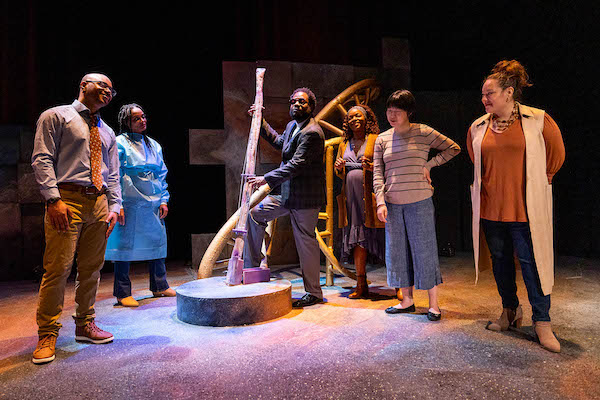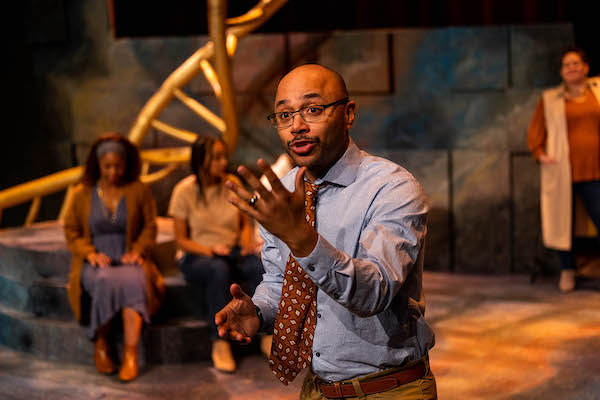Theater Review: “Young Nerds of Color” — Making the Invisible Visible
By David Greenham
Young Nerds of Color feels like a bit of an experiment, and it is the kind of creative research that we should hope will continue.
Young Nerds of Color, arranged by Melinda Lopez. Directed by Dawn M. Simmons. Original music composition by Nona Hendryx. Scenic design by Shelley Barish. Costume design by Rachel Padula-Shufelt. Lighting design by Andrea Sofia Sala. Produced as part of the Brit d’Arbeloff Catalyst Collaborative@MIT by Underground Railway Theater at Central Square Theater, Cambridge, through March 20.

Daniel Rios Jr., Kortney Adams, James Ricardo Milord, Lindsey McWhorter, Alison Yueming Qu, and Karina Beleno Carney in Young Nerds of Color. Photo: Nile Scott Studio
The more than 60 BIPOC scientists and mathematicians interviewed to create Young Nerds of Color all agree on one thing: they all have heard some version of the comment “You’re not like the rest of them.” Well-meaning white people — and we know who we are — are inclined to try to praise Black and Brown individuals by lifting them out of their cultural context. Immunologist Ann-Harper Jones (Kortney Adams) emphatically wants to know just what “the rest of them” means. “Do you mean my family?”
The implicit and explicit bias against Black and Brown people in mathematics and science is writ large in Melinda Lopez’s compilation script.
Dr. DC Lopez (Daniel Rios Jr.) shares a code-switching story. He was preparing an important paper and, in the first sentence, about to identify himself as a Colombian astrophysicist. His advisor recommended removing the identifier Colombian because it might trigger the reader’s biases. That served as a turning point; he began to examine the “invisible forces” that kept him from succeeding in his discipline at the same pace as others.
National Medal of Science winner Dr. Sylvester James Gates Jr. (James Ricardo Milord) recalls coming to MIT in 1969 because Boston was hailed as an enlightened city: it had been deemed the Athens of America. Instead, the scientist found that it was “the most overtly racist place I had ever lived, up to that point in my life.”
And it’s not just white people who are the problem. Professor Portia Long (Lindsey McWhorter) tells the audience, “My … my mom still calls me and says, ‘You sound too black on the phone, so, you know, you need to … change that up a little bit.’”
At a time that society is being forced to confront so many of its biases in so many areas of our lives, it is valuable to be reminded of the prejudices that exist in science and mathematics. Long (McWhorter) asks, “Why is it that Black talent is always considered an anomaly and not the normal?” It’s a central question that science and math professionals should examine. After all, she adds, “Science makes the invisible visible.”
Young Nerds of Color takes an ambitious step toward the start of a necessary and important conversation. The company of six actors — Karina Beleno Carney and Alison Yueming Qu, along with Adams, McWhorter, Milord, and Rios Jr. — take on the roles of interviewees as well as sharing the ideas of others in the discussion.
Playwright/arranger Lopez has broken the evening’s stories into about 15 thematically focused scenes. Composer Nona Hendryx (who some may know as a member of the funk/disco group Labelle) has created a hybrid soundscape that includes gospel, jazz, and funk. The performers sing as they weave through their episodes.
While it’s filled with interesting stories and some wonderful original music, Young Nerds of Color struggles at times with its own theatrical identity. The structure (particularly transitions) is blurry in places. There is no clear intellectual or emotional build to the stories or points of view as they accumulate. Granted, the plot is not intended to be linear, but it is sometimes a struggle to make sense of the shifting contexts, to comfortably follow each character’s perspective.
Some of the lack of clarity must fall at the feet of director Dawn M. Simmons, who endeavors to keep the actors moving — more like pulsating — through the space. She is intermittently successful at this: rushing performers about the stage is more distracting than it is illuminating. However, Shelley Barish’s set design may also contribute to the staging’s lack of clarity: there’s a circular ramped platform and two giant genome strands. It’s visually interesting, but ambiguous. Where in the world are we? The characters often refer to work in “the lab,” but in the play they exist in an abstract setting. The suggestion is that science floats free of any kind of concrete location. Thus Simmons is forced to come up with a form of conceptual choreography that works against the nuanced ebb and flow that powerful storytelling demands.

Daniel Rios Jr with Lindsey McWhorter, Alison Yueming Qu, and Karina Beleno Carney in Young Nerds of Color. Photo: Nile Scott Studios
It must have been a Herculean — or given the subject matter, perhaps Pythagorean — effort to sift through more than 60 interviews and whittle all that material down to a 75-minute play. But, admirable as the effort is, Lopez hasn’t managed to make Young Nerds of Color a compelling dramatic experience. It’s content to be a call to action. Dealing with facts and figures is the currency of these characters’ lives. They marvel at ganglion cells, supernovas, and pyrophoric materials.
They also marvel at the incongruity of it all. As Dr. D.J. Thomas, Milord says, “I just look back on it and recognize that I think it was a sense of dissonance that this Black guy could be in the same room doing the same physics problem as them and doing it well.”
And as Marvela Haynes, Adams even bites the hand that feeds her: “I know that the color of my skin has nothing to do with the ability to do mathematics, and yet when I look at the top mathematics departments in the US, I can’t help but notice that MIT, Princeton, Stanford, Harvard, Caltech do not have a single African-American professor.”
Young Nerds of Color feels like a bit of an experiment, and it is the kind of creative research that we should hope will continue. We all benefit in the effort — onstage and off- — to make invisible voices visible.
David Greenham is an adjunct lecturer of Drama at the University of Maine at Augusta, and is the executive director of the Maine Arts Commission. He has been a theater artist and arts administrator in Maine for more than 30 years.
Tagged: Dawn M. Simmons, Melinda-Lopez, Underground Railway Theater

A comment on a quotation from the play and a suggestion: “I can’t help but notice that MIT, Princeton, Stanford, Harvard, Caltech do not have a single African-American professor.” Of the universities mentioned only Harvard (earlier this year) has divested from fossil fuels. So, an essential point must be made and I will make whenever plays about science are mounted. The marvels of research and science, yes. Diversity of employment — by all means.
But, given the crisis of climate change , theaters need to do more to point out how much of the system — funding and controlling science — is working against the survival of the planet. My suggestion for the next dramatic conversation with scientists — talk with specialists about what is happening to nature and what will happen in the years to come. Capture the emotional toll the current catastrophe is taking on scientists — many are in mourning for what they see disappearing. Audiences need to feel that … we need to witness that. Theater can do more than empower — it can be a form of witnessing.